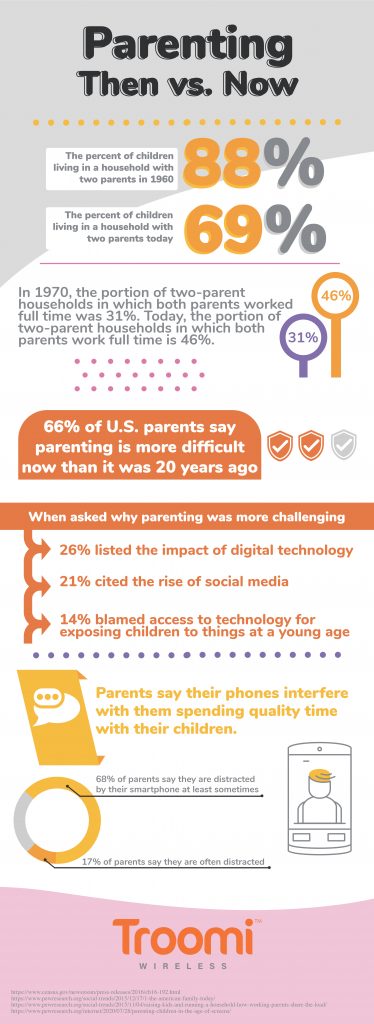
Do you ever feel like being a parent would have been easier in simpler times? Parenting is challenging no matter the era, but parents today face unique challenges compared to their past counterparts. According to Pew Research Center, sixty-six percent of U.S. parents say raising kids is more difficult now than it was two decades ago.
So, how has parenting changed over the years? Let’s take a look at parenting then and now.
Family dynamics are shifting
Nuclear families—households that consist of a married couple and their children—are on the decline. In 1960, almost ninety percent of children lived with two parents. Though most children—sixty-nine percent—still live in a two-parent home, the number of children living with single parents, grandparents, or who have other living arrangements has increased by twenty percent.
Size is another way today’s families differ from those of the past. ‘
Women are having fewer and fewer children. In 2020, the fertility rate in the U.S. was 1.78 births per woman, a steep decline from 3.65 in 1960. This could be partially due to modern parents waiting longer to have children. The average age at which parents have their first child has increased to 27 for mothers and 31 for fathers (up from 21 and 27, respectively, in 1970).
Parents are spending less time at home
In 1970, almost half of two-parent households consisted of a father who worked full time and a mother who did not work. Today, only a quarter of two-parent households feature that same dynamic. This shift alone accounts for many differences in parenting then vs. now, but there are more changes to consider.
Even in homes where both parents were working in 1970, they were less likely to be working full-time. Back then, only a third of homes consisted of two parents who worked full-time. Presently that share is forty-six percent.
The rise of single parenthood is another reason parents are working more and spending less time at home. Fifty years ago, only six percent of households were headed by solo parents; today, single-parent homes account for more than a quarter of all households.
Although more moms are working outside of the home now, both moms and dads are spending more time caring for and interacting with their children than the parents of five decades ago. This may be explained by a shift in social norms (see “intensive parenting” below) and the ability to multitask. Studies also show that parents are reallocating their time, reducing leisure time and time spent on household chores and spending more time with their kids.
“Intensive parenting” is imposing new pressures
You know the feeling—the pressure to make sure your child has the trendiest clothes, private dance lessons, and Montessori toys. Yes, there is a name for the expectation of spending every waking moment attending to your child. Intensive parenting refers to the idea that raising children successfully means devoting more energy and resources than most parents have. This is a relatively recent development. The rise of social media means the world is a stage, a phenomenon that only adds to the pressures of being a parent.
Technology is creating new challenges.
Many of the major differences between parenting then and now stem from the rise of technology. How has technology changed parenting? When asked why parenting was more challenging today, twenty-six percent listed the impact of digital technology, twenty-one percent cited the rise of social media, and fourteen percent blamed access to technology for exposing children to things at a young age. Parents also say their phones interfere with them spending quality time with their children. Sixty-eight percent say they are distracted by their smartphone at least sometimes, and seventeen percent say they are often distracted. Parents today face unique issues they would never have had to think about in the good old days.
Smartphone addiction
We can all relate to family dinners or game nights where everyone is staring at their phones instead of interacting with each other. This all-too-familiar scene showcases the rampant device addiction parents and kids struggle with today; the average adult spends almost four hours staring at screens every day, and the average teenager spends up to nine hours. Setting time limits, storing smartphones and tablets in a separate room from where you sleep at night, and turning off notifications are a few ways to reduce screen time.
Cyberbullying
Harassment, cyberstalking, impersonation, and other forms of trolling are unfortunately common on social media platforms, and its prevalence has increased with the rise of smartphones. You can safeguard your child from cyberbullying by limiting their social media use, setting up parental controls, and teaching them how to protect their privacy online.
Online predators
Spending too much time online puts children and teens at a higher risk of being exposed to online predators. Predators may try to befriend kids by creating fake profiles or posing as peers on apps, gaming platforms, and social media sites. Monitor your child’s online activity, communicate with them about the dangers of talking to strangers online (no matter how harmless they seem), and again, set up parental controls. When it comes to smartphones for kids, Troomi’s parent portal is the best out there. Use its SafeListing™ function to control who is allowed to contact your child, and choose from a list of KidSmart™ apps that have been vetted for safety.
Technology is also creating new opportunities
So far, we’ve focused on the negative impact technology has had on children, but don’t fret; tech also offers myriad benefits to today’s kids. So, how has technology changed parenting for the better?
Resources and support
Shared life experiences abound in online parenting groups and blogs. You can connect with others who are going through similar life phases, from pregnancy to empty-nesting. These forums allow topics that were formerly isolating or taboo to be discussed openly—and even anonymously. Online camaraderie is not a replacement for professional help, but it can be incredibly therapeutic. Why not share advice with other people who have been there?
Instant information
Is your child under the weather? Look up their symptoms in seconds, or hop on a telemedicine appointment with your pediatrician. Are they struggling with their algebra homework? Online tutors and thousands of educational videos can be colossal grade savers. Parents and children today have access to information beyond the wildest dreams of past generations.
Easy documentation
Capturing moments in photos and videos has never been easier. Gone are the days of lugging a Camcorder to Yellowstone; today’s high-quality smartphone cameras mean you can snag all of the grizzly and geyser footage you can dream of without the extra weight. Just don’t get too close!
It’s interesting to think about parenting then and now and how parenting has changed over time. The good news is that with all of the new dangers come new opportunities. With Troomi phones, you can empower your kids with the benefits of technology while keeping them safe from pornography and predators.

